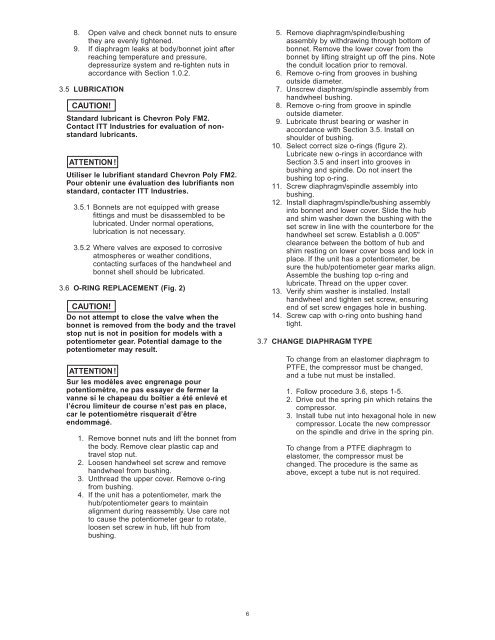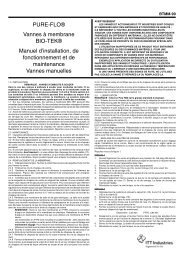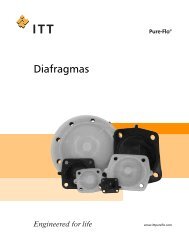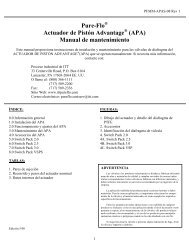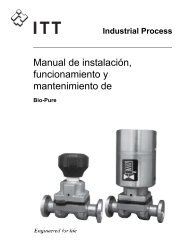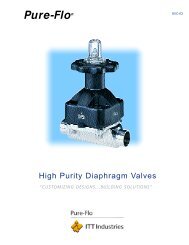PFMM-WFI-99 - Pure-Flo
PFMM-WFI-99 - Pure-Flo
PFMM-WFI-99 - Pure-Flo
Create successful ePaper yourself
Turn your PDF publications into a flip-book with our unique Google optimized e-Paper software.
8. Open valve and check bonnet nuts to ensure<br />
they are evenly tightened.<br />
9. If diaphragm leaks at body/bonnet joint after<br />
reaching temperature and pressure,<br />
depressurize system and re-tighten nuts in<br />
accordance with Section 1.0.2.<br />
3.5 LUBRICATION<br />
CAUTION!<br />
Standard lubricant is Chevron Poly FM2.<br />
Contact ITT Industries for evaluation of nonstandard<br />
lubricants.<br />
ATTENTION !<br />
Utiliser le lubrifiant standard Chevron Poly FM2.<br />
Pour obtenir une évaluation des lubrifiants non<br />
standard, contacter ITT Industries.<br />
3.5.1 Bonnets are not equipped with grease<br />
fittings and must be disassembled to be<br />
lubricated. Under normal operations,<br />
lubrication is not necessary.<br />
3.5.2 Where valves are exposed to corrosive<br />
atmospheres or weather conditions,<br />
contacting surfaces of the handwheel and<br />
bonnet shell should be lubricated.<br />
3.6 O-RING REPLACEMENT (Fig. 2)<br />
CAUTION!<br />
Do not attempt to close the valve when the<br />
bonnet is removed from the body and the travel<br />
stop nut is not in position for models with a<br />
potentiometer gear. Potential damage to the<br />
potentiometer may result.<br />
ATTENTION !<br />
Sur les modèles avec engrenage pour<br />
potentiomètre, ne pas essayer de fermer la<br />
vanne si le chapeau du boîtier a été enlevé et<br />
l’écrou limiteur de course n’est pas en place,<br />
car le potentiomètre risquerait d’être<br />
endommagé.<br />
1. Remove bonnet nuts and lift the bonnet from<br />
the body. Remove clear plastic cap and<br />
travel stop nut.<br />
2. Loosen handwheel set screw and remove<br />
handwheel from bushing.<br />
3. Unthread the upper cover. Remove o-ring<br />
from bushing.<br />
4. If the unit has a potentiometer, mark the<br />
hub/potentiometer gears to maintain<br />
alignment during reassembly. Use care not<br />
to cause the potentiometer gear to rotate,<br />
loosen set screw in hub, lift hub from<br />
bushing.<br />
6<br />
5. Remove diaphragm/spindle/bushing<br />
assembly by withdrawing through bottom of<br />
bonnet. Remove the lower cover from the<br />
bonnet by lifting straight up off the pins. Note<br />
the conduit location prior to removal.<br />
6. Remove o-ring from grooves in bushing<br />
outside diameter.<br />
7. Unscrew diaphragm/spindle assembly from<br />
handwheel bushing.<br />
8. Remove o-ring from groove in spindle<br />
outside diameter.<br />
9. Lubricate thrust bearing or washer in<br />
accordance with Section 3.5. Install on<br />
shoulder of bushing.<br />
10. Select correct size o-rings (figure 2).<br />
Lubricate new o-rings in accordance with<br />
Section 3.5 and insert into grooves in<br />
bushing and spindle. Do not insert the<br />
bushing top o-ring.<br />
11. Screw diaphragm/spindle assembly into<br />
bushing.<br />
12. Install diaphragm/spindle/bushing assembly<br />
into bonnet and lower cover. Slide the hub<br />
and shim washer down the bushing with the<br />
set screw in line with the counterbore for the<br />
handwheel set screw. Establish a 0.005"<br />
clearance between the bottom of hub and<br />
shim resting on lower cover boss and lock in<br />
place. If the unit has a potentiometer, be<br />
sure the hub/potentiometer gear marks align.<br />
Assemble the bushing top o-ring and<br />
lubricate. Thread on the upper cover.<br />
13. Verify shim washer is installed. Install<br />
handwheel and tighten set screw, ensuring<br />
end of set screw engages hole in bushing.<br />
14. Screw cap with o-ring onto bushing hand<br />
tight.<br />
3.7 CHANGE DIAPHRAGM TYPE<br />
To change from an elastomer diaphragm to<br />
PTFE, the compressor must be changed,<br />
and a tube nut must be installed.<br />
1. Follow procedure 3.6, steps 1-5.<br />
2. Drive out the spring pin which retains the<br />
compressor.<br />
3. Install tube nut into hexagonal hole in new<br />
compressor. Locate the new compressor<br />
on the spindle and drive in the spring pin.<br />
To change from a PTFE diaphragm to<br />
elastomer, the compressor must be<br />
changed. The procedure is the same as<br />
above, except a tube nut is not required.


